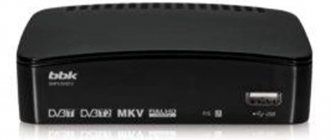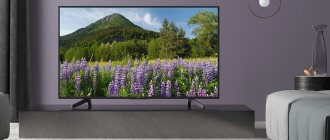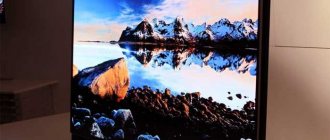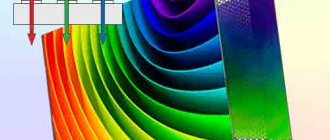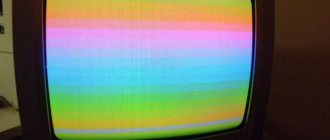Many people call any modern flat-screen TV “plasma”, which is wrong in 9 cases out of 10. Gas-discharge technologies, on the basis of which plasma TVs operate, are rarely found among ordinary people. For all its advantages, this is an expensive solution. More often, models are purchased that are built using liquid crystal modules. They cost an order of magnitude less, without being inferior in most respects
It is LCD monitors that will be discussed below. They come in two varieties: LCD and LED. The difference in technical performance is not as significant as it seems at first glance.
Let's look at this question in more detail.
Why can't you compare?
Let's compare LED and LCD
In fact, it is impossible to compare LED and LCD. Since the first abbreviation means a type of device group designated by the second. This is the same as asking: which is better - a car or a BMW.
Nevertheless, this is exactly how citizens are accustomed to dividing LCD monitors. Therefore, further, when we say “LED” we will mean this technology, and “LCD” we will include all other models of liquid crystal devices.
Expert advice on choosing an LED TV
When choosing a recipient, the buyer is guided primarily by his wallet. However, if the choice is narrowed in favor of an LED TV, you should take the advice of a specialist.
Consultants familiar with LED technology can advise you on:
- If you need to mount the receiver on the wall, look no further than the Edge LED. Its weight and thickness allow it to be hung even on drywall. If you don't pay attention to the glare around the edges, the model meets quality standards.
- If paying extra for electricity is not a problem, then a model with Direct LED and an RGB module will rightfully take its place for watching your favorite movies. The pleasure of processing every detail of the picture is worth the money spent.
- Since analog transmission is a thing of the past, digital video requires the highest resolution screen possible. Full HD panels are a priority. But if you have a small screen, HD Ready can handle it.
- Now you need 100Hz or even 200Hz to see a dynamic scene. The TV should display one to three teenagers. Receivers with scanning illumination are good at this. If you plan to watch 3D, you'll need the highest frequency.
- Glossy gives excellent contrast and brightness, but is annoying to look at in sunlight. The image on a matte surface is not as clear.
- Sooner or later you will have to connect other devices to your TV. Therefore, it is worth paying attention to the connectors that are present in the model. You'll need at least two HDMI interfaces, a pair of USB ports, and line-in I/O for picture and sound.
- Many note the presence of the popular Smart TV function. This is a very useful tool for multimedia applications available over an Internet connection. And if you need Internet access, you can't do without it.
Don't forget about sound. If a separate audio system is not connected, you need to test the quality of the native system. There should be no vibration or distortion when turning the volume icon up to ¾ full volume.
Structure of LCD displays
It makes no sense to go into depth into the operating principle of liquid crystal equipment: it will be difficult for an untrained reader to navigate all the intricacies. Within the framework of the article, it is enough to briefly mention the structure of the liquid crystal panel.
To simplify, an LCD matrix is two transparent plates divided into tiny cells. Each of these capsules is filled with a special substance – liquid crystal. The inside is covered with RGB color filters: red, blue or green. Each screen pixel includes three cells with inserts of different colors.
The liquid crystal substance has an amazing property. If an electric current is passed through it, it becomes translucent, remaining opaque in its normal state. Thus, if you illuminate the assembly from the inside, you can build a combination of multi-colored dots that together represent an image.
Structure of LCD screens
What is the difference between LED and LCD? Only in the way the backlight is implemented .
OLED TVs (Organic Light-Emitting Diode)
OLED TVs or LED panels are an innovative product that differs from LCD TVs not only in the type of backlight, but also in the structure of the matrix itself. Special organic light-emitting diodes are used here. But their role is not limited to just lighting. The OLED TV screen itself is made entirely of organic light-emitting diodes (without the use of liquid crystals). There is no longer any need to backlight the screen or use color filters. Organic LEDs themselves are a source of light and color and independently form an image on the screen.
Advantages. OLED technology allows you to generate millions of colors, making the image on the TV screen incredibly bright and rich. OLEDs can adjust shades of gray, produce perfectly pure whites and the deepest blacks. The viewing angle has virtually no effect on image quality, something LCD displays cannot boast of. As for the thickness of screens, OLED technology makes it possible to produce ultra-thin TVs - no thicker than a smartphone display.
Flaws. The selection of OLED TVs is still limited. But renowned manufacturers have already launched OLED TVs into mass production. But the price of OLED models corresponds to the “title” of an innovative product. The cost of high-tech OLED TVs is an order of magnitude higher than all other options.
What should you choose? Decide based on your own preferences and your budget. We tried to describe as clearly as possible the features of the three main types of TVs on the market today. The choice is yours. We are always happy to share useful information and help you place an order at Greenloft.ru .
LCD technology
A typical LCD backlight is a simple cold-light fluorescent lamp installed in the monitor housing in front of the display.
This lighting allows you to create a palette of different colors. Energy consumption for electroluminescent illumination is relatively low, but its operation requires a high-frequency alternating current source. Converters for the operation of a light source consume an average of 25 watts per hour.
LCD durability (brightness halved from the initial value) is approximately 5 thousand hours, which is affected by the set glow intensity.
Fluorescent lamp of conventional LCD monitors
Additional tips and insights
Don't take passport contrast seriously. This is a measure of dynamism. It is replaced by a local dimming system designed for LED matrices. In fact, the true value is different. And the bigger it is, the better.
Typically, standard TV settings are not suitable for viewing at home. Therefore, the first thing you need to do after you bring home your purchase, install and connect your LED TV is to make your own settings. But for this you need a high-quality signal source. Sometimes it's better to rely on your Internet provider. The digital video signal transmitted by the supplier via cable and over the air is of good quality.
Refresh rate should not be confused with refresh rate. The first one is often not mentioned in specifications. In older models it is 50 Hz. Newer ones have a refresh rate of 100 to 200 Hz.
Each manufacturer's update frequency is different. And to configure it, you need software methods that can be found in the manual for the model.
Experts say that older models of LCD TVs are far behind the improved models with LED technology. This is reflected in functionality, energy savings, service life and many other technical characteristics. And most importantly, regarding image quality.
LED technology
This backlight is made from a group of bright LEDs. For models with a small matrix size, tapes with built-in emitters are installed on only one side (most often on the side). In large-format devices, LEDs are installed over the entire display area.
The technical functioning of LEDs can be ensured from a 5V voltage source without the use of converters. This solution consumes minimal energy and can be used in compact portable devices.
To adjust the brightness of the glow, pulse width modulators are used.
LED backlighting in the monitor housing
How to turn on the LED backlight of a laptop screen
The backlight turning off is usually caused by problems with digital technology. Often such breakdowns occur 2-3 years after active use of the laptop. Let's name the popular reasons why the backlight turns off:
- breakdown of the inverter for voltage conversion;
- the backlight lamp of the laptop matrix has burned out;
- no power to the inverter;
- power circuits burned out;
- The integrity of the loop is compromised.
To fix the problem and turn on the LED backlight of the screen, you need to contact a service center for professional repair.
What type of monitor should I choose?
LED or LCD: which is better? Definitely, LED lighting for LCD matrices is preferable. Semiconductors win in many ways. Let's list the main ones.
- Low power consumption . LEDs do not require additional converters for power supply. The current limiter is the only component of the circuit that consumes energy. Backlight consumption, even on screens with a diagonal of 46+ cm, never exceeds 10 Watts, for standard household models – 3-5 Watts.
- Durability . LED service life is 50 thousand hours. At the same time, replacing LED strips is a simple and cheap procedure; repairs occur quickly and do not involve significant costs.
- Dimensions . The miniaturization of semiconductor devices makes it possible to make a monitor with a truly “flat” display. In a number of devices (for example, laptops) this is an indispensable solution.
- Color rendering quality . The difference between LED and LCD is that in the case of LEDs it is possible to distribute the backlight evenly around the perimeter of the screen. This improves contrast and increases image saturation. In addition, by changing the brightness of individual areas of the display, the problem of local dimming is solved.
Monitors and displays equipped with LED backlighting are a little more expensive, but the difference is not that significant. Choosing such a brand is an excellent compromise between price and performance. Efficient, with a bright “live” picture, ergonomic and trouble-free: the main qualities of a “correct” TV.
LCD technology is becoming a thing of the past; many manufacturers have already stopped mass production of devices with fluorescent lamps. The future belongs to semiconductor emitters.
Please rate the article. We tried our best:)
Did you like the article? Tell us about her! You will help us a lot :)
Functions of modern TV
TV has become an integral part of a person’s life and is not going to leave it. After Smart TV technology became available to the general public, television receivers are now increasingly used as a means of communication and tools for online entertainment. However, a classic TV without Smart TV technology also has a number of functions that are significant for the user. Models of LCD and LED types cope equally well with them
Organization of home cinema.
Modern TVs can showcase a number of outstanding features. They support the most common video formats and, when connecting additional devices, provide access to treasure troves of newsreels from any era. Today, LCD or LED TVs are created with HD and Full HD resolutions in mind. Gradually, the 4K format is becoming part of everyday life.
Flat liquid crystal panels display a three-dimensional image that immerses the viewer in an off-screen reality. Manufacturers also produce a wide range of devices with very good built-in speakers that create a deep and impressive sound effects experience. In addition, you can connect other audio devices to TVs.
Flat panel displays weigh significantly less than their predecessors, display better colors and allow the device to be placed directly on the wall. The Direct LED backlight type allows you to make the image much brighter and more contrasting.
Video game display
The gaming industry is developing at a rapid pace. Over ten million Russians are constantly or at certain points in their lives addicted to video games. Connecting set-top boxes and consoles to your TV allows you to get more pleasure from the gaming process. In order to use a television receiver for this purpose, you need to connect a set-top box, console or computer to it. The LED or LCD device must also support 3D and HD video format.
IMPORTANT! In order not to create difficulties during gameplay, the screen must have a minimum response time, wide viewing angles and reliable color reproduction. The Smart TV feature allows you to connect to online libraries. LCD or LED TVs are equally good at enjoying the gaming world.
Leave a request and receive a 15% discount on your first repair!
Submit your application
Decor element
Constructors and designers are constantly working to create more attractive and original TV models. They have developed devices with curved screens, mirror surfaces, thin artistic frames and displays of unusual shapes.
This area of production continues to prepare new surprises for the consumer.
